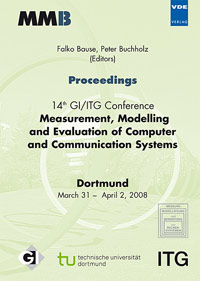Analysis of a Real-Time Network using Statistical Network Calculus with Effective Bandwidth and Effective Capacity
Conference: MMB 2008 - 14th GI/ITG Conference - Measurement, Modelling and Evalutation of Computer and Communication Systems
03/31/2008 - 04/02/2008 at Dortmund, Germany
Proceedings: MMB 2008
Pages: 15Language: englishTyp: PDF
Personal VDE Members are entitled to a 10% discount on this title
Authors:
Angrishi, Kishore; Killat, Ulrich (Institute for Communication Networks, 4-06, Hamburg University of Technology, Hamburg, Germany)
Abstract:
The Internet traffic consists of an increasing amount of soft real-time flows, which can tolerate very small delay variation and losses. Allowing probabilistic Quality of Service (QoS) violation for these flows can greatly help to improve resource utilization. However, this improvement depends on the statistical properties of competing independent flows and the resources (capacity and buffer) of the multiplexing link. The notion of effective bandwidth summarizes the statistical properties and the QoS requirements of the flow. Similarly, the time varying resource availability to the arrival process at the link can be summarized using the notion of effective capacity. This paper expresses the QoS measures at the link in terms of effective capacity using the large deviations theory. Further, it applies the general formulation of effective bandwidth and effective capacity within the framework of the statistical network calculus for an efficient per-hop analysis of the feed-forward network with finite number of independent sources. This new approach enables efficient utilization of statistical multiplexing of independent flows both at the ingress of the network and along the path of the flow.


